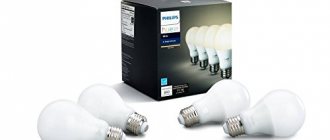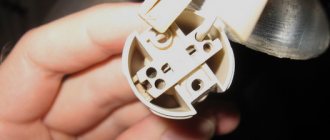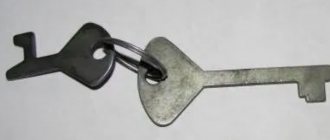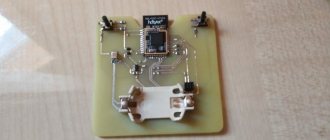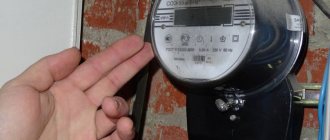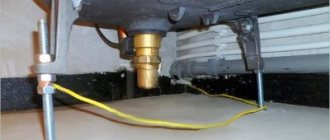In the modern world, energy-saving lamps (ESL) in lighting fixtures have almost completely replaced incandescent lamps. Thanks to their active use as lighting sources, in everyday life and in production, serious energy savings occur (about 20-25%).
Energy efficient lamps
Currently, the industry produces the following types of energy-saving lighting devices:
- luminescent;
- LED
Energy saving occurs due to the fact that an energy-saving or energy-efficient lamp has a higher efficiency. So, for an incandescent device this figure is 4%, for an LED device it is 30-40%, and for a compact fluorescent lamp (CFL) it is at the level of 20%.
Design and principle of a luminescent light source
An arc lamp consists of a sealed glass bulb, a high-frequency transducer and a base. The high-frequency converter is made on the basis of an electronic board. The flask is filled with gas, which includes mercury vapor. At the ends of the bulb there are filaments.
The device of a compact fluorescent light bulb
When the lamp is connected to the electrical circuit, a discharge occurs in the bulb. In this case, electromagnetic waves in the ultraviolet range are emitted. To convert ultraviolet radiation into visible light, a phosphor is applied inside the bulb.
Thus, according to their operating principle, fluorescent lamps belong to the gas-discharge type of radiation sources.
They can be performed in two versions:
- compact;
- linear.
A linear arc lamp is a traditional fluorescent lamp whose bulb is shaped like a cylinder.
Linear energy saving light bulb
The compact version is designed in exactly the same way as the linear one, but the bulb has a curved appearance, which allows it to be made in smaller sizes with the same electrical parameters.
Compact energy efficient light bulb
Since energy-saving lamps contain mercury vapor inside, it is necessary to handle such lighting fixtures carefully.
If the glass bulb of the lamp is intact, then the mercury contained inside it does not pose any danger to humans.
Even if the bulb falls off the base, but its seal is not broken, the mercury in it cannot enter the air and such a lamp also remains safe.
However, if the arc lamp was nevertheless broken, then in this case the contents inside the energy-saving lamp enter the surrounding air and may pose a danger to people in the room.
Broken ESL
What is the danger of damage to an energy-saving lamp?
- ⚡
firstly, these are small glasses that can easily cut you - ⚡
secondly, it is poisonous mercury vapor
In high-quality foreign lamps, mercury is usually contained in a special bound state, in the form of a so-called amalgam. And when the lamp breaks, mercury in contact with air should not spread in space.
Chinese analogues, if damaged, pose a real danger. One light bulb can contain up to five milligrams of mercury. For comparison, a thermometer, for example, contains up to 2 grams.
However, in a lamp, mercury is in a gaseous state and its distribution in the air occurs much faster. The minimum safe daily dose of mercury for one person is 0.0003 mg/m3.
Thus, if an energy-saving light bulb containing 5 mg of mercury breaks in your room with an area of 20-30 m2, the concentration of this dangerous substance in the room will exceed the permissible value hundreds of times!
Dangers of mercury entering the human body
What harm does broken fluorescent lamps cause?
Mercury belongs to the group of toxic substances. At high concentrations, it can cause the following phenomena in the body:
- headache;
- nausea;
- dry throat;
- diarrhea;
- abdominal cramps;
- damage to the liver, kidneys;
- disruption of the central nervous system, etc.
Exposure to mercury vapor is most dangerous for pregnant women and children.
If one light bulb in a room is broken, the harmful effects may not be immediately noticed, since the concentration of the toxic substance in one device is low. But, according to experts, mercury tends to accumulate in the human body, gradually poisoning it. The effects of the poison can be felt after five, ten or more years. Moreover, scientists claim that the consequences of exposure can be varied and quite serious. These include vision problems, dementia, various diseases of the nervous system, etc.
Types of mercury lamps
Here are the types of lamps that contain mercury:
- ⚡
Energy saving lamp - 5 mg - ⚡
DRL lamps - up to 350 mg - ⚡
Fluorescent lamp in the form of a tube - 45-65 mg - ⚡
Outdoor high-pressure lamp DRT - up to 600 mg - ⚡
Neon tube – 10mg
With prolonged inhalation of mercury vapor, damage to the nervous system can occur; with large doses of poisoning, deaths are possible. The most dangerous case is when the light bulb is depressurized, but does not break, and you consider it simply burned out and throw it in the trash.
As a result, your body will gradually accumulate mercury over a long period of time, the vapors of which will be present in the air of your apartment.
Therefore, all overheated, broken, non-working energy-saving lamps should be immediately thrown into specially designed containers, and not stored at home.
What to do if an energy-saving light bulb is broken
The consequences for the human body depend on how much mercury is in the energy-saving lamp. The mercury content in one device is 1-400 mg. The highest concentration is found in industrial type lamps. In a compact device its concentration is less than 5 mg.
The electricity meter is broken: what to do?
If the bulb of an energy-saving lighting device is broken in a room, then it will be necessary to do preventive cleaning of the room.
Attention! Energy-saving lamps, as well as fragments from them, are waste belonging to the first hazard class.
Procedure if a mercury-containing lamp breaks:
- Since children and pregnant women are most susceptible to mercury vapor, it is first necessary to remove them and animals from the room, after which you can proceed to further actions to clean the air and clean the room;
- The next step is to ventilate. You need to open all the windows in the room. At the same time, the doors to adjacent rooms of the house must be closed. Ventilation is carried out for 2 to 24 hours. During ventilation, it is best for everyone to leave the room in which the broken lamp is located. After 15-20 minutes of ventilation, you can begin further cleaning;
- A toxic substance can enter the body through the air a person breathes or through the skin. Therefore, to protect the respiratory tract, you need to wear a gauze bandage, and to protect the skin, shoe covers and rubber gloves. Instead of shoe covers and gloves, you can use plastic bags;
- Collect all the fragments that remain from the flask. For cleaning, use tape or other sticky tape. They can also be collected using a wet cloth;
- Also, for better collection of glass fragments, you need to perform wet cleaning with detergent or a 1% solution of potassium permanganate;
- At the end of the cleaning, all used materials and collected glass must be placed in a plastic bag and subsequently recycled;
- Next, it is advisable to take a shower;
- Clothes that were used for cleaning should be washed using washing powder.
If an energy-saving lamp breaks in a room with a carpeted floor, the carpet must be carefully rolled up and thrown outside. If possible, it is better to leave it outside for airing for several days.
Attention! It is environmentally unsafe to dispose of a burnt mercury-containing lighting fixture, even if its bulb is not damaged, in trash containers in the usual way. This can lead to the fact that the glass flask will be broken during disposal, and the toxic vapors contained in the gas will enter the air. Lamps are handed over only to special collection points intended for these purposes.
Disposal points for faulty energy-saving lighting devices
From collection points they are sent to factories designed for recycling mercury lighting devices.
Industrial recycling of mercury-containing devices
If not one, but several lamps are broken, it is not recommended to clean the room yourself. In this case, the concentration of mercury in the air will be quite high. Therefore, to perform this work, it is better to contact specialists who have special protective equipment.
Special collection points are equipped for recycling energy-saving lamps. Their addresses can be found in housing offices, in the district administration or on the Internet.
What not to do if an energy-saving light bulb breaks:
- Do not attempt to clean indoors without using primary protective equipment (gloves and gauze);
- Do not allow a draft to arise in the room in which the mercury lamp has broken. Because in this case, toxic fumes will spread throughout the house. Therefore, you must first close all the doors to the room and only then open the windows;
- Use a vacuum cleaner to collect the remains of the flask. If cleaning is done with its help, the mercury will settle inside the vacuum cleaner itself and its further use will be unsafe for the owners themselves. For the same reason, it is not recommended to use an air conditioner to ventilate the room;
- Try to collect the fragments with a broom or broom. This is especially true when an energy-saving lamp breaks on a carpet. This can lead to small pieces of glass scattering around the room and completely collecting them will be problematic;
- After washing the surface, do not pour used water into the sewer system. Since when mercury enters water bodies, it turns into the highly toxic substance methylmercury (with the chemical formula [CH3Hg]+) in the process of metabolism by bottom microorganisms. Methylmercury compounds are highly toxic and bioavailable, so they accumulate in the bodies of river and lake fish living in polluted water bodies. If a person eats such fish, then the human body is poisoned. Therefore, water, as well as all rags, adhesive tapes and other materials used for cleaning, should only be disposed of by specialists;
- Throw away gloves, shoe covers, masks, rags, and debris in a garbage chute or trash can. They are placed in an ordinary plastic bag and taken to a recycling point.
Currently, there are energy-saving lamps on sale that contain mercury amalgam or its alloy with other metals. This substance contains mercury in a bound state. Thanks to this, mercury does not evaporate at room temperature, and therefore, if an energy-saving light bulb of this type breaks, mercury vapor does not enter the surrounding air.
You can determine whether there is mercury in a lighting device or not as follows. Lamps made using this technology must be marked on the packaging “Does not contain mercury” (in the English version “Amalgam technology”).
Using energy-saving mercury-containing gas-discharge lighting will allow you to use more energy in your home. Only during their transportation, installation and operation must strict safety regulations be observed.
Procedure
What to do if you break an energy-saving lamp?
- ⚡
first, ask your family and friends to leave the apartment immediately. The less people breathe contaminated air, the better. - ⚡
close the door in the room where the light bulb broke and open all the windows in the house for at least 10-15 minutes. Your task is to reduce the concentration of mercury vapor - ⚡
collect the pieces from the light bulb
Put on a damp gauze bandage and use rubber gloves, paper towels, an old sponge, that is, everything that you don’t mind throwing away along with the glass. Do not remove debris with a vacuum cleaner.
- ⚡
The fragments should not be thrown into a regular trash bin. Place them in a tight bag and twist it so that it does not allow air to pass through - ⚡
carry out wet cleaning of the place where the fragments lay. After cleaning, also throw the rag into a sealed bag. - ⚡
the bag will subsequently need to be thrown away not in a regular trash bin, but in a special container for such lamps.
If the fragments fell on a rug or carpet, then it must be taken outside, an oilcloth laid under the carpet and then knocked out. Oilcloth with splinters is of course thrown away, and the carpet will need to be ventilated for a long time.
//youtu.be/HTmgYkViX1g
How to dispose of a broken or burst light bulb
After an energy-saving lamp breaks, you will have to collect the fragments and mercury. In scientific circles, it is called demercurization after the designation of the chemical element. The same procedure is suitable if you break a mercury thermometer. The whole process should be divided into several stages; let’s look at each of them in more detail.
Procedure
First, you should designate one person responsible for cleaning the energy-saving lamp. If the whole family is gathered, there is no need for them all to inhale harmful fumes; it is better for the rest of the household to go outside. The person in charge is selected as the most attentive and scrupulous member of the family.
Secondly, it is necessary to localize air pollution; to do this, close the doors to the room. And windows and vents are opened to ensure an influx of fresh air and ventilation, as a result, some of the vapors will evaporate into the street, which will have a beneficial effect on well-being and the situation as a whole.
Thirdly, remove any remaining glass by following these steps:
- Wear rubber gloves for cleaning premises - they are quite durable, airtight and you don’t mind throwing them away after the procedure. Use a mask or respirator to protect your respiratory tract.
- It is better to collect all the elements from an energy-saving lamp on thick cardboard or plastic, which will also have to be thrown away. Sweep with a sponge or cloth; if you do this with a broom and dustpan or vacuum cleaner, they will also be subject to disposal, which may be unacceptable for you;
- All fragments are collected in order - from largest to smallest, the largest can be taken with your fingers, the smaller ones can be swept onto paper, and the smallest fragments can be blotted with a damp sponge.
The fragments are removed in order
Lastly, collect the luminescent coating if it spilled separately and the mercury balls if you broke the thermometer.
Collect the fragments in a plastic bag, preferably one that has a zipper to ensure it is sealed. If you don’t have this on hand, use several simple bags and place a sponge and cardboard in it.
The package with the contents is sent to a special container for energy-saving lamps or transferred to an organization specializing in their recycling.
Next, demercurize the room; for this at home, the following methods may be suitable:
- potassium permanganate solution at the rate of 2 g per liter;
- a mixture of 40g baking soda and 40g soap solution per liter of water;
- dilute 100 ml of iodine per liter of water.
Using the resulting solution, you need to wet clean the room where the energy-saving lamp has broken, wearing gloves.
Pay special attention to recesses and crevices where mercury may have settled. Apply the solution to the surface and leave for 4 - 6 hours, then rinse with warm water
The procedure should be repeated 3 to 4 days in a row to completely get rid of the harmful element.
Storage Features
Temporary storage of waste of hazard class 1 is permitted for no more than 6 months in special sealed containers.
The company provides warehousing and storage of used lamps, in accordance with the requirements of standards and in accordance with certain conditions:
- the storage facility is located away from production and office premises, observing the standards;
- the layout of the internal space should provide access to any storage area. This will ensure unhindered placement, transportation and accumulation of waste;
- Roof leakage is not allowed;
- installation of ventilation is required;
- the presence of unauthorized persons is excluded;
- damaged light elements are placed in separate boxes for storage;
- availability of necessary disinfectants and protective equipment;
- the method of storing and storing used lamps must ensure their integrity;
- The lamps are placed in containers by holding them carefully by the base. Water must not enter;
- all actions related to the transportation of mercury-containing lamps are reflected in the accounting log;
- In case of violation of storage conditions, administrative liability arises.
The rules for storing fluorescent lamps for enterprises must be strictly and strictly observed.
Which lamps contain mercury?
Depending on the filling pressure, there are low-pressure RLs (RLND), high-pressure RLs (RLVD) and ultra-high-pressure RLs (RLSVD).
Expert opinion
It-Technology, Electrical power and electronics specialist
Ask questions to the “Specialist for modernization of energy generation systems”
Mercury, LED and regular: which light bulbs are the most dangerous - Recycle This will lead to the fact that the maximum permissible concentration of highly reactive and hygroscopic mercury vapor contained in the atmosphere of the house will exceed the norm by 5 to 10 times, depending on the area of the space. Ask, I'm in touch!
How much mercury is contained in 1 light bulb
The concentration of mercury inside an energy-saving light bulb depends on its type and power. Each manufacturer indicates the indicator on the individual lamp packaging.
For example, the following lamp options are considered:
- Room ESL contains up to 5 mg of mercury.
- DLR lamp – up to 350 mg.
- Luminescent tubular – 45–65 mg.
- DRT lantern – up to 600 mg.
- Neon tube – up to 10 mg.
The fact is taken into account that the dangerous content of mercury in the air for the body is 0.25 mg/cu. So, one broken light bulb will not have much serious impact on your health. But there is no need to avoid precautions and preventive measures.
How to eliminate the danger
Eliminating the danger from a broken lamp includes mechanical cleaning, demercurization and waste disposal. Let's look at the stages in more detail.
Mechanical cleaning
All mechanical cleaning work must be carried out by a responsible adult; others must leave the area, including pets.
Before cleaning, it is important to close the doors to other rooms and open the windows wide
Next, you should assemble all parts of the device. When removing lamp fragments, under no circumstances should you touch them with your bare hands. All work is carried out with thick gloves, and the residue is collected with a sponge, cardboard or rag. You cannot use a vacuum cleaner, otherwise you will have to get rid of it.
Mechanical cleaning of the premises.
All parts of the device are placed in a tight bag with a sealed clasp. The surface is wiped with a damp cloth or towel, which is also placed in a tight bag for disposal.
The contact of substances with decorative elements is also a reason to place them in sealed bags for further examination. Experts will be able to assess the degree of contamination and draw a conclusion about the suitability of the item for further use.
Demercurization
Upon completion of mechanical cleaning, immediately begin cleaning the room, demercurization - removing all mercury residues and neutralizing compounds absorbed into the surfaces. Thorough cleaning using special solutions is required.
Options for homemade neutralizers:
- Dissolve 2 grams of potassium permanganate in 1 liter of water and mix.
- Dissolve 400 grams of soda and 400 grams of soap in a 10-liter bucket. In this case, soda can be replaced with another chlorine-containing composition.
- 100 ml of iodine dissolves in 1 liter of clean water.
The compositions are inexpensive and prepared quickly, which is convenient for treating large areas.
Wipe all surfaces in the room where the lamp broke with the solution.
Pay special attention to cracks, hidden cavities and hard-to-reach areas. All work should be carried out exclusively with thick rubber gloves.
Demercurization of surfaces.
After application, it is advisable to leave the solution on the surfaces for several hours. To completely remove harmful substances, it may be necessary to repeat the treatment for 3-4 days.
You can turn to special companies that use specialized tools and methods for demercurization services. After the procedure, employees will measure the content of mercury vapor in the air and evaluate the interior items affected by the substance.
Disposal
All that remains is to remove the bag of lamp waste from the apartment. You cannot throw such waste into a regular bin; you need to find a specialized collection for hazardous waste. In large cities, such tanks are easy to find, but for residents of small cities it is more difficult.
Lamp ejection point.
For consultation, call the Ministry of Emergency Situations or the sanitary and epidemiological station. Specialists will coordinate and recommend the best disposal option. You can contact local large businesses that should have hazardous waste disposal bins available.
What not to do?
- Turn on the air conditioner if there is one - mercury vapor will settle inside the device.
- Collect the remains of the lamp with a vacuum cleaner - again, the mercury will settle inside.
- You should not use a broom - careless movements can scatter small pieces of glass around the room.
- Pour the jar of water and remaining glass down the drain.
- Throw away the broken lamp or the can with the remains of the lamp in the trash or down the garbage chute.
Used (burnt-out) energy-saving lamps cannot be disposed of together with household waste; they should be taken to special collection points.
Author:
Sabuk Tatyana Leonidovna hygienist, epidemiologist
Why buy LED lamps?
Conventional light bulbs provide excellent light, but are very energy inefficient - 95% of their energy is converted into heat.
Fun fact: after the ban on the sale of light bulbs more powerful than 100 W, manufacturers, as if nothing had happened, continue to produce them, but they call them not light bulbs, but “heat emitters” and in essence they are right. Modern LED lamps consume 8-10 times less energy than incandescent lamps with the same luminous flux, which means that when lighting with LED lamps you can pay 8-10 times less for lighting.
I calculated the cost of lighting a two-room apartment with conventional and LED lamps.
Of course, the calculation is very approximate. Nevertheless, 3-5 thousand rubles per year is a very real saving for an average apartment. Pay attention to the burning time of the lamps. Manufacturers promise 1000 hours of incandescent lamp operation (in reality, light bulbs often burn out much earlier), but even if the lamps work their 1000 hours, they will have to be changed in the hallway and room twice a year, and in the kitchen and bedroom once. With an average cost of a lamp of 30 rubles, this will cost another 690 rubles.
LED lamps do not have to be changed every six months. Manufacturers promise 25-50 thousand hours of operation. This is more than 11-22 years with daily use for 6 hours.
A set of LED lamps for this average apartment will cost 4,380 rubles (7 E27 6W lamps for 280 rubles, 11 4W candles for 220 rubles) and they will pay for themselves in less than a year.
Good LED lamps provide the same comfortable light as incandescent lamps and you will not be able to distinguish their light from that of incandescent lamps.
A 60-watt incandescent lamp, when the network voltage drops to 207 V, begins to shine like a 40-watt lamp, and if the voltage drops to 180 volts (which often happens in rural areas), the 60-watt lamp “turns” into a 25-watt lamp. The LED lamp shines with the same brightness at any voltage and is not afraid of voltage surges.
Unlike incandescent lamps, LED lamps generate little heat. Lamps do not warm the room when it is already hot. The child will not get burned on the light bulb in the table lamp.
LED bulbs also give you freedom and comfort. You no longer have to worry about saving electricity: when a light bulb consumes 6 W instead of 60, you can simply leave it on. I used to always turn off the light in the hallway, now it's always on when I'm at home. It's more convenient.
And one last argument in favor of buying LED lamps. Don't treat them like consumables. You buy them for a long time. Treat them the same way you treat the chandelier or lamp you install them in, because most likely someday you will replace them together, because LED lamps will never burn out.
Consequences
Mercury vapor is dangerous to health because it can cause chronic poisoning, which is manifested by hand tremors, gingivitis, and disturbances in the functioning of the central nervous system. With a high concentration of vapors (massive breakdown of energy-saving light bulbs), acute mercury poisoning is possible, which is manifested by weakness, abdominal pain, vomiting and bleeding gums (see symptoms of mercury poisoning).
Mercury in vapor form is most dangerous for children and pregnant women, so it is important to know how to act in such a situation. One broken lamp will not cause serious harm, but this does not mean that precautions can be ignored.
